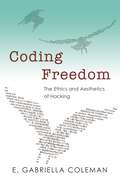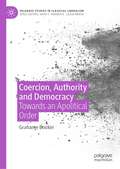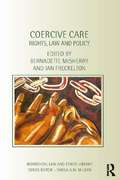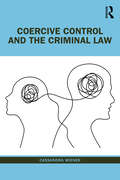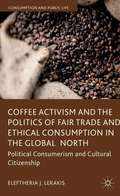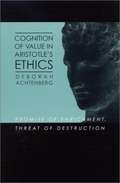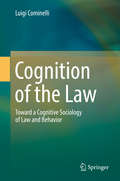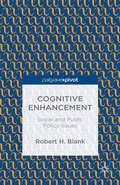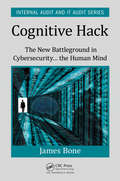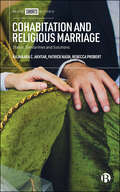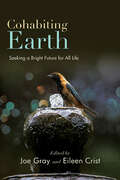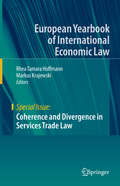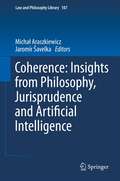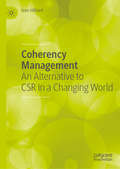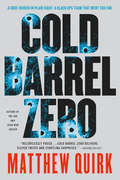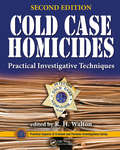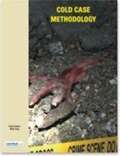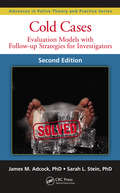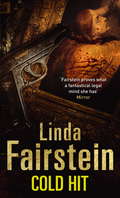- Table View
- List View
Coding Freedom: The Ethics and Aesthetics of Hacking
by E. Gabriella ColemanWho are computer hackers? What is free software? And what does the emergence of a community dedicated to the production of free and open source software--and to hacking as a technical, aesthetic, and moral project--reveal about the values of contemporary liberalism? Exploring the rise and political significance of the free and open source software (F/OSS) movement in the United States and Europe, Coding Freedom details the ethics behind hackers' devotion to F/OSS, the social codes that guide its production, and the political struggles through which hackers question the scope and direction of copyright and patent law. In telling the story of the F/OSS movement, the book unfolds a broader narrative involving computing, the politics of access, and intellectual property. E. Gabriella Coleman tracks the ways in which hackers collaborate and examines passionate manifestos, hacker humor, free software project governance, and festive hacker conferences. Looking at the ways that hackers sustain their productive freedom, Coleman shows that these activists, driven by a commitment to their work, reformulate key ideals including free speech, transparency, and meritocracy, and refuse restrictive intellectual protections. Coleman demonstrates how hacking, so often marginalized or misunderstood, sheds light on the continuing relevance of liberalism in online collaboration.
Coercion, Authority and Democracy: Towards an Apolitical Order (Palgrave Studies in Classical Liberalism)
by Grahame BookerClassical liberalism has typically sought to maintain as much room as possible for the exercise of personal initiative in the face of the encroachment of states. This book explores these questions of coercion and authority in the context of the size and scope of the state and argues that the state and its agents should be held to the same moral rules as are the individuals it rules over. The book considers how a distinct feature of the state is its police or coercive power, about which one may ask how the state acquires it and what if anything would justify its use. It considers the implication that there is nothing inherent about state agents that entitles one to behave in ways that we would not accept from a private actor, and how once that argument is made, the state’s claim to authority is weakened. The author also discusses the extent to which democracy has been thought to provide any sort of justification for coercion or authority. This book will be of interest to academics and students of political philosophy, especially classical liberalism, and legal philosophy.
Coercive Brain-Reading in Criminal Justice: An Analysis of European Human Rights Law (Law and the Cognitive Sciences)
by Sjors LigthartEmerging neurotechnology offers increasingly individualised brain information, enabling researchers to identify mental states and content. When accurate and valid, these brain-reading technologies also provide data that could be useful in criminal legal procedures, such as memory detection with EEG and the prediction of recidivism with fMRI. Yet, unlike in medicine, individuals involved in criminal cases will often be reluctant to undergo brain-reading procedures. This raises the question of whether coercive brain-reading could be permissible in criminal law. Coercive Brain-Reading in Criminal Justice examines this question in view of European human rights: the prohibition of ill-treatment, the right to privacy, freedom of thought, freedom of expression, and the privilege against self-incrimination. The book argues that, at present, the established framework of human rights does not exclude coercive brain-reading. It does, however, delimit the permissible use of forensic brain-reading without valid consent. This cautionary, cutting-edge book lays a crucial foundation for understanding the future of criminal legal proceedings in a world of ever-advancing neurotechnology.
Coercive Care: Rights, Law and Policy (Biomedical Law and Ethics Library)
by Bernadette McSherry Ian FreckeltonThere has been much debate about mental health law reform and mental capacity legislation in recent years with the UN Convention on the Rights of Persons with Disabilities also having a major impact on thinking about the issue. This edited volume explores the concept of ‘coercive care’ in relation to individuals such as those with severe mental illnesses, those with intellectual and cognitive disabilities and those with substance use problems. With a focus on choice and capacity the book explores the impact of and challenges posed by the provision of care in an involuntary environment. The contributors to the book look at mental health, capacity and vulnerable adult’s care as well as the law related to those areas. The book is split into four parts which cover: human rights and coercive care; legal capacity and coercive care; the legal coordination of coercive care and coercive care and individuals with cognitive impairments. The book covers new ground by exploring issues arising from the coercion of persons with various disabilities and vulnerabilities, helping to illustrate how the capacity to provide consent to treatment and care is impaired by reason of their condition.
Coercive Control and the Criminal Law
by Cassandra WienerThis book considers how a phenomenon as complex as coercive control can be criminalised. The recognition and ensuing criminalisation of coercive control in the UK and Ireland has been the focus of considerable international attention. It has generated complex questions about the "best" way to criminalise domestic abuse. This work reviews recent domestic abuse criminal law reform in the UK and Ireland. In particular, it defines coercive control and explains why using traditional criminal law approaches to prosecute it does not work. Laws passed in England and Wales versus Scotland represent two different approaches to translating coercive control into a criminal offence. This volume explains how and why the jurisdictions have taken different approaches and examines the advantages and disadvantages of each. As jurisdictions around the world review what steps need to be taken to improve national criminal justice responses to domestic abuse, the question of what works, and why, at the intersection of domestic abuse and the criminal law has never been more important. As such, the book will be a vital resource for lawyers, policy-makers and activists with an interest in domestic abuse law reform.
Coffee Activism and the Politics of Fair Trade and Ethical Consumption in the Global North: Political Consumerism and Cultural Citizenship
by Eleftheria J. LekakisThis book explores the politics borne of consumption through the case of coffee activism and ethical consumption. It analyses the agencies, structures, repertoires and technologies of promotion and participation in the politics of fair trade consumption through an exploration of the relationship between activism and consumption.
Cognition of Value in Aristotle's Ethics: Promise of Enrichment, Threat of Destruction
by Deborah AchtenbergArguing that metaphysics is central to ethics for Aristotle, Achetenberg (philosophy, U. of Nevada, Reno) uses a variety of strategies including textual interpretation as well as broader types of interpretation--elucidation of terms and their meanings in English, examination of a variety of texts from ancient Greek thought, and comparison of Aristotle's views with those of other philosophers and thinkers of different types. Annotation copyrighted by Book News, Inc.
Cognition of the Law: Toward a Cognitive Sociology of Law and Behavior
by Luigi CominelliThis book’s basic hypothesis – which it proposes to test with a cognitive-sociological approach – is that legal behavior, like every form of human behavior, is directed and framed by biosocial constraints that are neither entirely genetic nor exclusively cultural. As such, from a sociological perspective the law can be seen as a super-meme, that is, as a biosocial constraint that develops only in complex societies. This super-meme theory, by highlighting a fundamental distinction between defensive and assertive biases, might explain the false contradiction between law as a static and historical phenomenon, and law as a dynamic and promotional element. Socio-legal scholars today have to face the challenge of pursuing a truly interdisciplinary approach, connecting all the fields that can contribute to building a modern theory of normative behavior and social action. Understanding and framing concepts such as rationality, emotion, or justice can help to overcome the significant divide between micro and macro sociological knowledge. Social scientists who are interested in the law must be able to master the epistemological discourses of different disciplines, and to produce fruitful syntheses and bridge-operations so as to understand the legal phenomenon from each different point of view. The book adopts four perspectives: sociological, psychological, biological-evolutionary and cognitive. All of them have the potential to be mutually integrated, and constitute that general social science that provides common ground for exchange. The goal is to arrive at a broad and integrated view of the socio-legal phenomenon, paving the way for a comprehensive theory of norm-oriented and norm-perceived actions.
Cognitive Enhancement: An Interdisciplinary Perspective (Trends in Augmentation of Human Performance #1)
by Elisabeth Hildt Andreas G. FrankeCognitive enhancement is the use of drugs, biotechnological strategies or other means by healthy individuals aiming at the improvement of cognitive functions such as vigilance, concentration or memory without any medical need. In particular, the use of pharmacological substances (caffeine, prescription drugs or illicit drugs) has received considerable attention during the last few years. Currently, however, little is known concerning the use of cognitive enhancers, their effects in healthy individuals and the place and function of cognitive enhancement in everyday life. The purpose of the book is to give an overview of the current research on cognitive enhancement and to provide in-depth insights into the interdisciplinary debate on cognitive enhancement.
Cognitive Enhancement: Social and Public Policy Issues
by Robert H. BlankRapid advances in cognitive neuroscience and converging technologies have led to a vigorous debate over cognitive enhancement. This book outlines the ethical and social issues, but goes on to focus on the policy dimensions, which until now have received much less attention. As the economic, social and personal stakes involved with cognitive enhancement are so high, and the advances in knowledge so swift, we are likely to see increasing demands for government involvement in cognitive enhancement techniques. The book therefore places these techniques in a political context and brings the subsequent considerations and divisions to the forefront of the debate, situating their resolution within the milieu of interest group politics. The book will provide a starting point from which readers can develop a balanced policy framework for addressing such concerns.
Cognitive Hack: The New Battleground in Cybersecurity ... the Human Mind (Security, Audit and Leadership Series)
by James BoneThis book explores a broad cross section of research and actual case studies to draw out new insights that may be used to build a benchmark for IT security professionals. This research takes a deeper dive beneath the surface of the analysis to uncover novel ways to mitigate data security vulnerabilities, connect the dots and identify patterns in the data on breaches. This analysis will assist security professionals not only in benchmarking their risk management programs but also in identifying forward looking security measures to narrow the path of future vulnerabilities.
Cohabitation and Religious Marriage: Status, Similarities and Solutions
by Rajnaara C. Akhtar, Patrick Nash and Rebecca ProbertCohabiting couples and those entering religious-only marriages all too often end up with inadequate legal protection when the relationship ends. Yet, despite this shared experience, the linkages and overlaps between these two groups have largely been ignored in the legal literature. Based on wide-ranging empirical studies, this timely book brings together scholars working in both areas to explore the complexities of the law, the different ways in which individuals experience and navigate the existing legal framework and the potential solutions for reform. Illuminating pressing implications for social policy, this is an invaluable resource for policy makers, practitioners, researchers and students of family law.
Cohabiting Earth: Seeking a Bright Future for All Life
by Joe Gray; Eileen CristThe eco-catastrophes that we are witnessing today starkly demonstrate how the interests of the Earth's currently dominant species are in lockstep with those of nature's wider whole. Simply stated, humans and the more-than-human world have a shared fate. Just as humanity's unrestrained overreach in the ecosphere is driving a mass extinction event and causing the devastation of lifeforms and places, so it is also jeopardizing the prospect of a human future worth living. There is no "humans versus nature" tradeoff: the wellbeing of both is inseparably entwined. Solutions to the shared predicament of all Earth's beings will thus necessarily be those that strive for harmony between human presence and the rest of nature. This applies to the philosophy we adopt for agriculture, the ways in which human economies operate, our patterns of consumption, and numerous other intertwined threads of our existence. This anthology argues that harmony between humanity and our home planet must be built on the pillars of restraint, respect, and reverence.
Coherence and Divergence in Services Trade Law (European Yearbook of International Economic Law)
by Markus Krajewski Rhea Tamara HoffmannThis book addresses topical questions concerning the legal framework of trade in services, and assesses how these issues are dealt with in GATS and in selected preferential trade agreements. In addition, the chapters discuss whether the differences and similarities (if any) are evidence of greater coherence or greater divergence. The book combines the individual analyses to provide a more comprehensive picture of the current law on services trade liberalisation.A quarter of a century after the conclusion of the General Agreement on Trade and Services (GATS), international law on trade in services is still in a state of flux: on the one hand, countries increasingly conclude bilateral and regional trade agreements with sections on trade in services that aim at a further liberalisation of services trade. On the other, the GATS structure remains the dominant model and serves as the basis for many preferential trade agreements. In addition, new aspects such as electronic commerce, data protection and taxation are now emerging, while issues that had already manifested in the mid-1990s such as financial services regulation, labour mobility, and telecommunications continue to be problematic. Usually, the debates focus on the question of whether preferential trade agreements serve as a stepping-stone or stumbling block for trade liberalisation at the multilateral level. However, it can be assumed that rules on trade in services in preferential trade agreements will coexist with the global GATS regime for the foreseeable future. This raises the question of whether we’re currently witnessing a drive towards greater coherence or more divergence in agreements on trade in services.
Coherence: Insights From Philosophy, Jurisprudence And Artificial Intelligence (Law and Philosophy Library #107)
by Michał Araszkiewicz Jaromír ŠavelkaThis book is a thorough treatise concerned with coherence and its significance in legal reasoning. The individual chapters present the topic from the general philosophical perspective, the perspective of legal-theory as well as the viewpoint of cognitive sciences and the research on artificial intelligence and law. As it has turned out the interchange of knowledge among these disciplines is very fruitful for each of them, providing mutual inspiration and increasing understanding of a given topic. This book is a unique resource for anyone interested in the concept of coherence and the role it plays in reasoning. As this book captures important contemporary issues concerning the ongoing discussion on coherence and law, those interested in legal reasoning should find it particularly helpful. By presenting such a broad scope of views and methods on approaching the issue of coherence we hope to promote the general interest in the topic as well as the academic research that centers around coherence and law.
Coherency Management: An Alternative to CSR in a Changing World
by Ivan HilliardThis book presents a new approach to corporate responsibility based on the concept of coherency, permitting better understanding and management of the conflicting forces that strive to create value across the stakeholder spectrum. In doing so, it provides an alternative to the limited and ineffective role currently played by Corporate Social Responsibility (CSR), and offers an approach more in line with the needs of a sustainable society. Hilliard introduces several new concepts in management philosophy and presents an innovative and original framework for managing organizational responsibilities in a coherent manner.
Cold Barrel Zero (John Hayes Series #1)
by Matthew QuirkA CODE HIDDEN IN PLAIN SIGHT. A BLACK OPS TEAM THAT WENT TOO FAR.John Hayes is a Special Operations legend who went rogue on a deep-cover mission and betrayed his own soldiers. Disgraced and on the run, he returns to the United States to get back to his wife and daughter and take revenge on his accusers with a series of devastating attacks.Only one man can stop him: Thomas Byrne. He once fought alongside Hayes as a combat medic, but he gave up the gun. Now a surgeon, he moves from town to town, trying to forget his past, until he is called upon by a high-ranking government official to help capture the man he once called a friend.Hayes and Byrne were once as close as brothers, but with the fate of the nation hanging in the balance and nothing as it seems, both men must decide whom to trust--and whom to betray. In a final, explosive battle for justice, they face off along a rifle's cold barrel.Cold Barrel Zero brings together the blistering pace of Lee Child, the nonstop action of Brad Thor, and the richly drawn characters and moral stakes of Daniel Silva. An experienced reporter armed with deep behind-the-scenes research into America's Special Operations Forces, Quirk takes the military thriller to a new level of suspense.
Cold Case Homicides: Practical Investigative Techniques, Second Edition (Practical Aspects of Criminal and Forensic Investigations)
by R.H. WaltonThis book, now in its second edition, is the first and most exhaustive text covering the still growing popularity of cold case investigations which locate perpetrators and free the innocent. The new edition adds approximately 80 pages of content, including material on clandestine graves and investigating cold gang cases. The book merges theory with practice through the use of case histories, photographs, illustrations and checklists that convey essential, fundamental concepts while providing a strong, practical basis for the investigative process.
Cold Case Methodology
by Michael King Gregory CooperThis text is designed to provide students with an overview and practical understanding of the processes, theories and investigative techniques of Cold Case Investigations. Operative and sequential procedures that lead to successful closure of Cold Cases will also be examined. Covered areas include; development of cold case units, solvability factors, review and evaluation of evidence, and the basic and advanced technological methods employed by Cold Case squads. This textbook is appropriate for criminal justice, criminal investigation, and homeland security programs. It is also suited for programs in emergency management, corporate security, psychology, emergency medical services and healthcare, police academy programs, and continuing professional development.
Cold Case Research Resources for Unidentified, Missing, and Cold Homicide Cases
by Silvia PettemCases in which all investigative leads appear to be exhausted are frustrating for both investigators and victims families. Cold cases can range from those only a few months old to others that go back for decades. Presenting profiles and actual case histories, Cold Case Research: Resources for Unidentified, Missing and Cold Homicide Cases illustrat
Cold Cases: Evaluation Models with Follow-up Strategies for Investigators (Advances In Police Theory and Practice Series)
by James M. Adcock Sarah L. SteinBecause the investigation of cold cases is usually an arduous and time-consuming task, most law enforcement agencies in the United States are not able to dedicate the resources necessary to support the cold case investigation process. However, when those cases are fully pursued and prosecuted, they often result in convictions and lengthy prison terms. <p><p>Cold Cases: Evaluation Models with Follow-up Strategies for Investigators, Second Edition saves law enforcement time by providing detailed guidelines for determining if a cold case is solvable, and if so, how to organize, manage, and evaluate the investigation. It also provides techniques for developing investigative strategies to complement the evaluation process and resolve the crime. <p><p>This second edition features a new revised model and methodology for investigating cold cases suitable for all police and public safety agencies--large or small, domestic or international. This new model is more expeditious and convenient for departments that have less manpower and experience in dealing with cold cases. It emphasizes the prioritization of cold cases based on the availability of physical evidence and the chances of deriving matches from said evidence and an identified person of interest. <p><p>Additional topics covered in the second edition include: - How cases go cold - Strategies for creating a cold case unit - Cold Case investigations in a Dutch educational environment--a chapter written by members of the Dutch Police Academy - New forensic Science technologies, including DNA, CODIS, and AFIS - Case studies demonstrating advances in suspectology - Strategies for effective investigative interviewing - Challenges posed by staged crime scenes in cold cases - How to craft a cold case evaluation report <p>The expert authors of this book maintain The Center for the Resolution of Unresolved Crimes
Cold Cases: Evaluation Models with Follow-up Strategies for Investigators, Second Edition (Advances in Police Theory and Practice)
by James M. Adcock Sarah L. SteinBecause the investigation of cold cases is usually an arduous and time-consuming task, most law enforcement agencies in the United States are not able to dedicate the resources necessary to support the cold case investigation process. However, when those cases are fully pursued and prosecuted, they often result in convictions and lengthy prison terms. Cold Cases: Evaluation Models with Follow-up Strategies for Investigators, Second Edition saves law enforcement time by providing detailed guidelines for determining if a cold case is solvable, and if so, how to organize, manage, and evaluate the investigation. It also provides techniques for developing investigative strategies to complement the evaluation process and resolve the crime.This second edition features a new revised model and methodology for investigating cold cases suitable for all police and public safety agencies—large or small, domestic or international. This new model is more expeditious and convenient for departments that have less manpower and experience in dealing with cold cases. It emphasizes the prioritization of cold cases based on the availability of physical evidence and the chances of deriving matches from said evidence and an identified person of interest.Additional topics covered in the second edition include: How cases go cold Strategies for creating a cold case unit Cold case investigations in a Dutch educational environment—a chapter written by members of the Dutch Police Academy New forensic science technologies, including DNA, CODIS, and AFIS Case studies demonstrating advances in suspectology Strategies for effective investigative interviewing Challenges posed by staged crime scenes in cold cases How to craft a cold case evaluation report The expert authors of this book maintain The Center for the Resolution of Unresolved Crimes and conduct training and consulting worldwide. Their practical book is designed to help law enforcement agencies resurrect long-forgotten cases, bringing closure to victims and holding accountable those who are responsible. This book is part of the Advances in Police Theory and Practice series
Cold Cases: Famous Unsolved Mysteries, Crimes, and Disappearances in America
by Hélèna KatzThis book explicitly chronicles 40 cases of unsolved murders and disappearances over a period of more than 160 years, tracing the evolution of criminal investigation and forensic techniques.
Cold Hit (Alexandra Cooper #3)
by Linda FairsteinOn a steamy August evening, after an exhausting day in court, Assistant DA Alexandra Cooper is called to a crime scene. Alongside her colleagues, NYPD detectives Mike Chapman and Mercer Wallace, she views the body of a young woman pulled from the water with her hands and feet obscenely tied to a ladder. But who is she? Her elegant clothes and manicured nails suggest affluent connections, but just how well-connected she is surprises even Alex.From luxurious Fifth Avenue apartments to the avant garde galleries of Chelsea, Alex, Mike and Mercer hunt for a killer in a world where priceless art meets big money in a lethal mix.
Cold Justice
by Jonnie JacobsDwayne Davis, aka the Bayside Strangler, has been dead for a year when Anne Bailey, a defense lawyer formerly on the prosecution team that got Davis the death penalty, is killed in the Strangler's signature style. Anne's law partner, Kali O'Brien, was also involved in the Davis case and notifies her former boss, San Francisco DA Owen Nelson, of the similarities. Nelson fears that bad press could derail his run for governor and persuades Kali to rejoin the payroll and run the case to forestall cover-up charges. She soon has her hands full as the bodies pile up, and she must deal with woman-hating cop Lou Fortune, creepy stalker Nathan Sloane and a growing suspicion that she could be next on the killer's list. A romantic attraction to Lou's partner, Det. Bryce Keating, further complicates affairs. Former attorney Jacobs (Witness for the Defense) has a magic touch with characters from sleazy Mission Street hoods to political power brokers. Clues sometimes give away too much too soon, but menacing red herrings and Technicolor personalities pace the woman-in-peril plot and sharpen the suspense. The author pulls off the neat trick of featuring a lawyer protagonist in a character-driven police procedural that never sees the inside of a courtroom. This is a smash installment in a popular series that is easy to relate to and relentlessly entertaining. Copyright 2002 Cahners Business Information, Inc.
